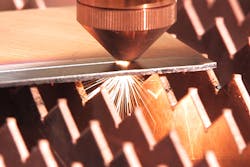First Direct-Diode Laser Slices Through Metal
Start-up company TeraDiode, Wilmington, Mass., has taken technology developed in MIT’s Lincoln Laboratory to develop the first metal-cutting machine that uses only laser diodes — there are no intervening crystals for amplification or focus. The new machine, dubbed TeraBlade, is said to be more efficient (40%) and less expensive than other industrial lasers, including carbon-dioxide, but is just as powerful. The company claims its 4-kW direct-diode laser puts out 2,600 MW per square centimeter per steradian and can slice through a half-inch of steel.
In the past, engineers trying to boost the output of diode lasers ended up with low-quality laser beams or poor focus. Moreover, lasers based on diodes alone were never powerful enough for industrial use. First-generation devices are carbon dioxide lasers and were developed decades ago. They are bright, but can be the size of trucks and operate at about 20% efficiency. Second-generation lasers, diode-pumped solid-state lasers, including disk and fiber, usually send energy through an amplifying crystal, before converting it into a laser beam. And they were limited to about 30% efficiency.
The TeraBlade, however, uses a power-scaling technique called wavelength beam combining. It overlaps or combines several laser beams from diodes into one more powerful yet still coherent beam.
The laser module inside the TeraBlade contains diode laser bars (long arrays of diode lasers), a transform lens, diffraction grating, and output lens. Light from the diode lasers passes through the transform lens and onto the carefully positioned diffraction grating, a glass plate carefully etched with parallel lines. The diffraction grate, which is usually used to disperse light beams at various angles, forces them into the same direction, superimposing them into one beam. The entire TeraBlade, a 3-ft cube, includes several laser modules, a control computer, power supplies, and an output head for welding and cutting.
The company is already sold selling its cutting machines to customers in countries such as Japan and Germany, where energy costs are high. For example, in April the company shipped TeraBlades to Panasonic Welding Systems in Europe and Japan. Other customers include top global builders of industrial laser-based machines and system integrators.
The company anticipates defense applications for its lasers. One idea is to build a defensive laser weapon that protects against heat-seeking missiles. It would fire an infrared laser at the missile and interfere with its computer, causing the missile to lose its target. The laser’s relatively compact design would let it be carried by bombers, cargo planes, and even fighter jets.
